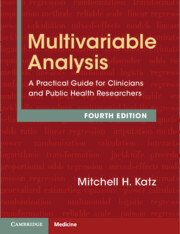Book contents
- Multivariable Analysis
- Multivariable Analysis
- Copyright page
- Contents
- Preface
- 1 Introduction
- 2 Common Uses of Multivariable Models
- 3 Outcome Variables in Multivariable Analysis
- 4 Independent Variables in Multivariable Analysis
- 5 Relationship of Independent Variables to One Another
- 6 Setting Up a Multivariable Analysis
- 7 Performing the Analysis
- 8 Interpreting the Results
- 9 Delving Deeper: Checking the Underlying Assumptions of the Analysis
- 10 Propensity Scores
- 11 Correlated Observations
- 12 Sensitivity Analysis
- 13 Validation of Models
- 14 Special Topics
- 15 Publishing Your Study
- 16 Summary: Steps for Constructing a Multivariable Model
- Index
10 - Propensity Scores
Published online by Cambridge University Press: 09 October 2025
- Multivariable Analysis
- Multivariable Analysis
- Copyright page
- Contents
- Preface
- 1 Introduction
- 2 Common Uses of Multivariable Models
- 3 Outcome Variables in Multivariable Analysis
- 4 Independent Variables in Multivariable Analysis
- 5 Relationship of Independent Variables to One Another
- 6 Setting Up a Multivariable Analysis
- 7 Performing the Analysis
- 8 Interpreting the Results
- 9 Delving Deeper: Checking the Underlying Assumptions of the Analysis
- 10 Propensity Scores
- 11 Correlated Observations
- 12 Sensitivity Analysis
- 13 Validation of Models
- 14 Special Topics
- 15 Publishing Your Study
- 16 Summary: Steps for Constructing a Multivariable Model
- Index
Summary
Propensity scores are a statistical method for adjusting for baseline differences between study groups. The scores are based on the probability of a subject being in a particular group, conditional on that subject’s values on those independent variables though to influence group membership. Propensity scores with multivariable analysis produces a better adjustment for baseline differences than simply including potential confounders in a multivariable model predicting outcome. Propensity scores are also particularly helpful when outcomes are rare and the proportions of subjects in the independent groups are relatively equal. Another advantage of propensity scores is that they make no assumptions about the relationship between the individual confounders and outcome. The adequacy of a propensity score is judged by whether there is sufficient overlap between the groups and whether it balances the covariates.
There are four major ways you can use propensity scores: matching, weighting, stratified, as a covariate in a model predicting outcome.
Keywords
Information
- Type
- Chapter
- Information
- Multivariable AnalysisA Practical Guide for Clinicians and Public Health Researchers, pp. 187 - 201Publisher: Cambridge University PressPrint publication year: 2025
Accessibility standard: Inaccessible, or known limited accessibility
Content Navigation
Allows you to navigate directly to chapters, sections, or non‐text items through a linked table of contents, reducing the need for extensive scrolling.
Provides an interactive index, letting you go straight to where a term or subject appears in the text without manual searching.
Reading Order & Textual Equivalents
You will encounter all content (including footnotes, captions, etc.) in a clear, sequential flow, making it easier to follow with assistive tools like screen readers.
You get more than just short alt text: you have comprehensive text equivalents, transcripts, captions, or audio descriptions for substantial non‐text content, which is especially helpful for complex visuals or multimedia.
You can access graphs or charts in a text or tabular format, so you are not excluded if you cannot process visual displays.
Visual Accessibility
You will still understand key ideas or prompts without relying solely on colour, which is especially helpful if you have colour vision deficiencies.
You benefit from high‐contrast text, which improves legibility if you have low vision or if you are reading in less‐than‐ideal lighting conditions.
